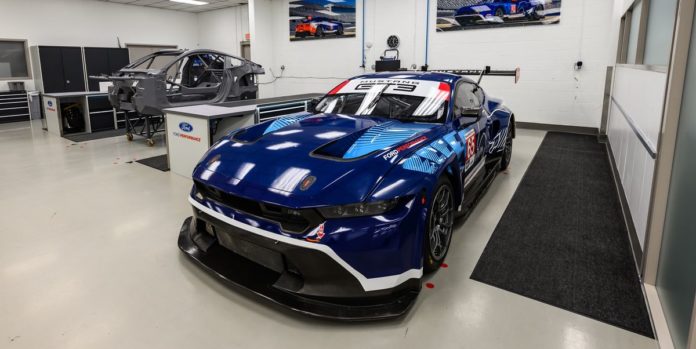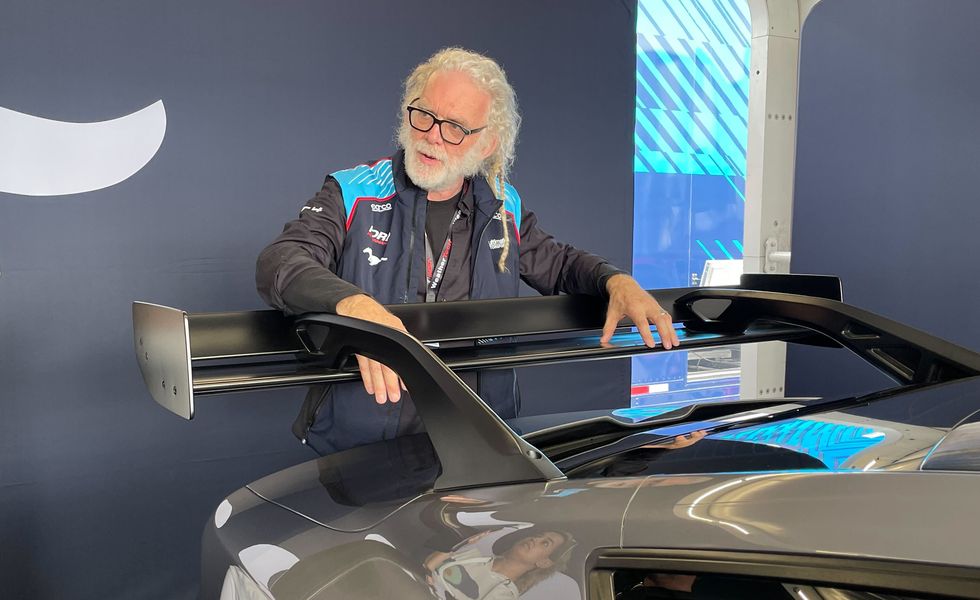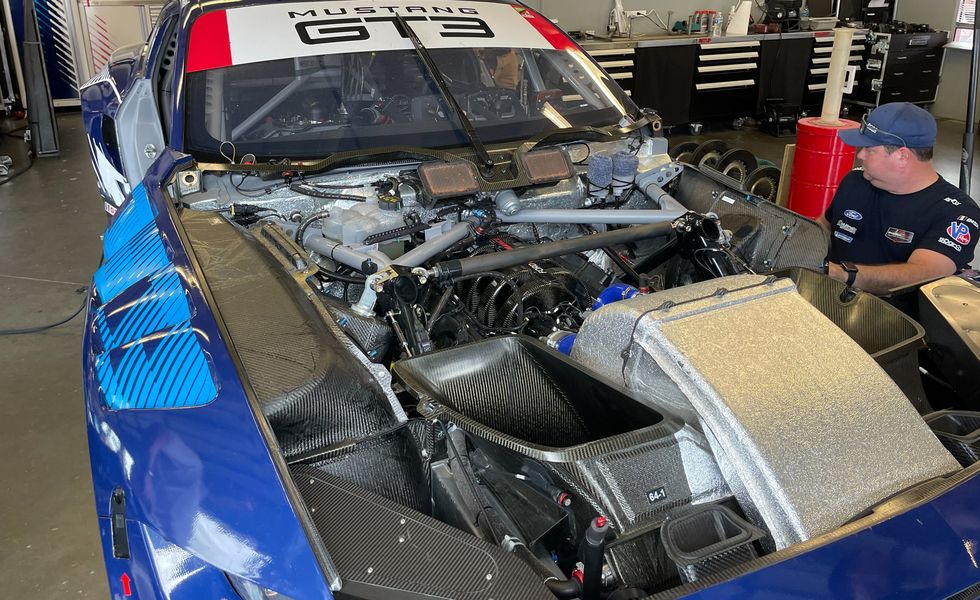When Ford CEO Jim Farley decided to build a road version of the Mustang GT3 race car, he didn’t chat about it to the public. Instead, he formed a skunkworks team in closed-door meetings so secretive that they included non-disclosure agreements for everyone involved. As the idea for the Mustang GTD started to take shape, the secret meetings progressed to an unmarked aluminum shed while Mustang Dark Horse chassis were being quietly brought to Multimatic, the manufacturing goliath in charge of both GT3 and GTD efforts.
The first time the public caught wind of the GTD wouldn’t come until much later. On March 21, 2023, Jim Farley posted a video to X (formerly known as Twitter), showing factory driver Joey Hand testing the Mustang GT3 race car around Sebring. That same day he would respond to his own tweet with a rhetorical “Should we make a road version?” Of course, by the time Farley made those posts, the GTD was already well into development; we just hadn’t seen it yet.
Any Track, Any Weekend
In an effort to learn a bit more about the GTD, we accepted Ford’s recent invitation to tour the Multimatic facility in Charlotte, North Carolina, where the Mustang GT3 race cars are built—and then on to the Rolex 24 at Daytona to see them in action. We looked forward to the chance to get some insight into why Ford has put the time, money, and effort into both projects.
We posed that question to Mark Rushbrook, global director of Ford Performance Motorsports, and his answer was simple: With Mustang sales growing in Europe and the 60th anniversary of the nameplate coming up, Ford wants to build a connection with fans around the world. That connection comes from having Mustangs racing at any track around the world on any weekend. It also includes getting Ford involved in GT3 racing for the first time since the departure of the GT following the 2019 season. As for the GTD—according to Larry Holt (the mad scientist in charge of engineering and motorsport operations for Multimatic)—well, that’s all Jim Farley’s idea.
Production-Car Roots
Like any other GT3 race car, the Mustang GT3 starts its life on the production line. The race car is derived directly from the Dark Horse road car; Holt and his team at Multimatic take what they learn from the GT3 car and reverse-engineer it to fit the roadgoing GTD. “From road to race, and race to road,” explained Rushbrook.
The relationship between the two cars is apparent the moment you lay eyes on them. From the widened front fenders to the twin air vents in the hood to the gooseneck wing mounts at the back of the cars, the similarities are prolific.
With balance of performance rules stifling some of the engineering aspects of the GT3 car, Multimatic can use things like a drag reduction system (DRS) for the rear wing to make the GTD a more rounded performance car in some ways than the race car. “Every surface on that car is based in function,” Holt tells us, waving to the GTD. Information including findings from wind tunnel testing for the GT3 is applied directly to the GTD. Data on the louvers located on the front fenders is shared between teams—according to Holt, they remove about 200 pounds of lift from the car. Even the underside of the GTD takes after the race car, though there are some differences. Ford hasn’t given specific figures regarding the GTD’s downforce levels, but we did learn that both the race car and the GTD can produce as much as 1500 to 2000 pounds at over 150 mph. We also learned that in order to keep the center of pressure from jumping around the car, the GTD reduces its front downforce when the DRS flap is open.
Every Surface Based in Function
With the hood removed and the “Ford Performance” script written along the top of the engine peeking out from its carbon-fiber nest, the race car’s production roots can be hard to imagine. But like every other GT3 engine, the Mustang’s naturally aspirated 5.4-liter V-8 started life on the production line. Though balance of power regulations keep the GT3’s power near the 550-hp mark, the GTD isn’t subject to governing body rules and regulations. In the GTD, the outgoing Mustang Shelby GT500’s supercharged 5.2-liter V-8 is tuned up to 800 horsepower and a dry-sump oil system is added; its doughnut-shaped reservoir occupies the area directly behind the engine block where the traditional 10-speed automatic transmission would lie.
Since the race car doesn’t have to follow the same safety regulations as normal road cars, Multimatic is able to stuff the 5.4-liter V-8 incredibly low down and far back in the engine bay, literally wrapping the firewall around the engine. To offset some of the nose-heaviness created by the front-mounted V-8, both cars utilize a rear transaxle in the space of a traditional trunk, along with a transmission cooler that’s fed air by two scoops at the leading edge of the trunk lid. The air from the transmission cooler is then fed out through vents between the taillights.
Development on both cars continues even now that the GT3 car has started racing. We sat down with Rushbrook roughly 18 hours into the Rolex 24 to get his thoughts on how the race was unfolding. As you might expect, several gremlins reared their heads as the race progressed. When testing alone on a track, tire debris isn’t an issue, but when racing bumper to bumper with other cars, the Ford Performance team discovered that small pieces of rubber were finding their way through the protective mesh screens in the nose of the car.
Still, “the issues we’re experiencing today are far less significant than the 2016 GT debut,” said Rushbrook. That Ford GT GT3 car would go on to win the LM GTE Pro class at Le Mans in the same year. Despite the disappointing sixth- and ninth-place class finishes at Daytona, there’s a lot of racing left for the Ford Performance Mustang GT3 this year to beat back some of those gremlins, and there are still quite a few months of development before Ford and Multimatic will let anyone drive the GTD.
Gremlins or not, we’ll be impatiently waiting for the GTD like a kid counting down the days to Christmas.
Jack Fitzgerald’s love for cars stems from his as yet unshakable addiction to Formula 1.
After a brief stint as a detailer for a local dealership group in college, he knew he needed a more permanent way to drive all the new cars he couldn’t afford and decided to pursue a career in auto writing. By hounding his college professors at the University of Wisconsin-Milwaukee, he was able to travel Wisconsin seeking out stories in the auto world before landing his dream job at Car and Driver. His new goal is to delay the inevitable demise of his 2010 Volkswagen Golf.



